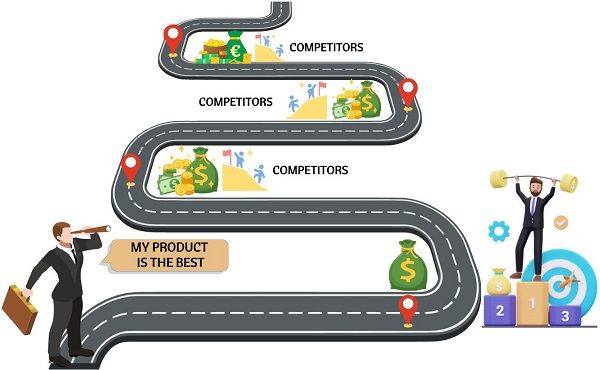You might have observed that some brands and products fail despite being successful at some point. The primary reason behind their failure is a disease named Marketing Myopia.
It is the firm’s near-sightedness towards its product, strategies and market definition.

In general, Myopia or near-sightedness is a vision disorder wherein one faces difficulty in seeing objects at a distance. However, they can see the near ones clearly.
It was first diagnosed by the American economist Theodore Levitt. He published an article titled ‘Marketing Myopia‘ in the Harvard Business Review (1960).
The firms suffering from Myopia fail to identify the industry they actually belong. Moreover, they presume to have the best product and focus more on selling them.
Marketers tend to be more product-oriented and focus less on the actual need of the end-user. Their view is restricted to cater the instant needs and ignores the big picture.
For example, the production houses think that they are in the film business. But, they don’t realize that they actually belong to the entertainment business.
Today, OTT platforms, YouTube and similar applications became their biggest competitors.
Many firms and products wipe out of the market every year. They often think of market saturation as the cause of their failure.
But, the actual reason is the management’s inability to forecast and adopt changes. Specifically, the changes in the requirements, tastes and preferences of customers.
Firms do not adopt it willingly, but lack of insight leads them towards Myopia.
Content: Marketing Myopia
- Example
- Background
- How to identify?
- Causes
- How to avoid it?
- Self-deceiving Cycle
- Green Marketing Myopia
- Sustainability Marketing Myopia
- Final Words
Example
Here, we have listed some popular companies suffering from Myopia:
- Hollywood
- Yahoo
- Walkman
- Nokia
- Blackberry
- Kodak
- Railroad
- Murphy Radio
Case 1: Blackberry and Nokia
These brands were industry leaders and even had a significant market share. Eventually, they lost their market to giants like Samsung and Apple.

The reason for this downfall was their myopic view towards their products. They believed that their technology and products were the best and unbeatable.
They didn’t adopt the newer technologies that customers liked, i.e. Android and IOS. Consequently, the customers switched to these platforms.
However, Nokia recently launched a new range of android mobile phones. But, once firms lose their market, it isn’t easy to regain it.
Case 2: Kodak
Kodak cameras topped the list of all the photographers and customers in that era. It got hit by Myopia and resisted digitalization.
Customer’s switched to digital cameras, and Kodak ultimately headed towards bankruptcy.
Background – Marketing Myopia by Theodore Levitt
Levitt tried to find the reason for the downfall of the businesses that were once successful. He identified that these businesses had a narrow definition of the business in which they were in.
He explained this concept by taking examples of Hollywood and Railroad companies. Furthermore, he suggested that the business must constantly ask themselves:
What business are you in?
Who are your customers?
Important points suggested by Theodore Levitt:
- Integrate customer requirements into the business plan.
- Identify and analyze the customer’s needs and wants.
- Have a clear understanding of the market and customers.
- A good product is a flop if customers won’t buy it.
- Develop customer-focused advertisement campaigns.
How to identify?
To identify whether you are myopic or not, you must analyze the following:
- Are your business and marketing strategies purely product-oriented?
- Is your product satisfying the end user’s needs, or is it even beneficial to them?
Causes
In the past few decades, the global business environment has changed. Consequently, many firms got affected by Myopia this while.
The causes of being myopic may vary across firms. However, the most common ones are explained below:
- Self-oriented Marketing: The firms engaged in this type of marketing suffer from ‘Seller’s Market Syndrome‘. They are obsessed with their products.
- Wrong or Narrow Definition of Markets: Some firms narrowly define their markets even after being successful. They ultimately lose a significantly large number of customers.
- Mass Production and Marketing: It restricts management from fragmenting a large consumer base into segments. Thereby, unable to reach and approach potential customers.
- Lack of Forecasting: Some marketers feel that they can’t predict the future. So, they keep on forming short-term goals. But, for survival, predicting and matching the customer’s expectations is necessary.
- Ever-lasting Product: After introducing a unique product, firms assume they have a monopoly and can’t be replaced. Practically, every innovation and product is replaceable.
Besides these, the firms having responsive market orientation also become myopic. This is because, they have a narrow vision for their existing customers. Therefore, they do not consider the changes in customers’ needs over time.
How to avoid it?
A cure for marketing myopia is difficult. This is because, firms need to change their entire perspective towards business. However, we can avoid getting into such a situation.
Firms must begin by revisiting their vision and mission statements. After that, redefine them as per their long-term goals and current market scenario.
The firms can consider below points to avoid Marketing Myopia:
- Keep customers as the top priority.
- Study your customer and their requirements.
- Always set and work for long-term goals.
- Update your marketing strategy after a specific period.
- Take research-based decisions.
- Always be visionary and avoid a myopic mindset.
- Innovate to keep pace with the fast-moving world.
- Conduct competitive analysis to know them better.
Self-deceiving Cycle
The growth industry is a myth, as growth is never assured. Instead, the successful ones keep grabbing opportunities to remain in the growing industry.
Almost every declining industry became part of the self-deceiving cycle. Usually, it happens with those who do not accept changes and ultimately get trapped.
As per Levitt, firms get caught in the self-deceiving cycle under the following four conditions:
- The business will grow with the growth in the population.
- The product is irreplaceable, and there is no substitute for it.
- Mass production will generate demand for itself.
- Promoting product qualities without research.
Green Marketing Myopia
It is acknowledged in the companies offering Green or Eco-friendly products.
Very often, marketers position their products, emphasizing their green qualities. But, they overlook elements like product functionality and customer satisfaction. Thus, we can say that the company is facing Green Marketing Myopia.

The customers may even purchase the products considering the green qualities. But, if the product is unable to satisfy their needs, then they won’t repurchase it. Subsequently, the products will fail, and the company will suffer losses in the long run.
How to avoid Green Marketing Myopia?
To avoid getting into such a situation, marketers must try to create the right mix of the product’s green qualities and functionality. They must not overemphasise or ignore either of the above elements. By this, they will be able to survive in the market much longer.
In addition, they must accommodate the non-green qualities in the products. Consequently, it will deliver more value to the customers being good for the environment.
Sustainability Marketing Myopia
It is a part of sustainability marketing. Here, the marketer focuses more on the socio-environmental aspects of the sustainable product and service. Moreover, they possess a myopic view towards customers’ requirements and values.
Green and sustainability marketing myopia seem similar. Conceptually, the origin is the same, but they have a difference in the span of coverage. The latter covers a boarded perspective, including service and after-sale services.
Final Words
More than 50% of new and existing firms suffer from Marketing Myopia. They are extensively running product-centric marketing campaigns.
Having a myopic view, they only focus on their products and existing customers. Thereby leaving space for the competitors to garb, notice and serve the potential customers.
To become successful and survive, firms must become customer-oriented. Besides sales, they must develop and deliver products that customers actually want.
Leave a Reply